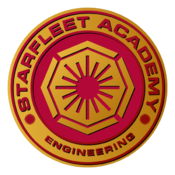Spore Drive
The Captain's Council is currently reviewing their official stance on the Spore Drive.
| Academy Library |
|---|
The Spore Drive, otherwise known as a displacement-activated spore hub drive or s-drive, is an advanced form of propulsion technology developed in the mid 23rd century by Starfleet, on the research ships USS Discovery and USS Glenn. It is an organic propulsion system utilizing mycelium spores harvested from Prototaxites stellaviatori to jump or leap across the mycelial network. During such jumps, a ship is not in normal space but in the mycelial plane, a discrete layer of subspace. Fleet Deployment
Basics of Spore DriveSpeedThe experimental Spore Drive has no theoretical speed limit. From an outside perspective, the ship disappears and reappears in another location almost instantly. The USS Glenn completed a jump of 90 light-years in 1.3 seconds, but they hit a Hawking radiation firewall returning to normal space, which caused the death of the crew. Drive staminaThere is no known endurance limitations related to the underlying technology of the Spore Drive. Rather, the stamina is limited to the endurance of the "pilot" navigating the mycelial network. Each jump requires the pilot to "feel" his way through the network. A few jumps in succession isn't difficult. However, when the USS Discovery jumped 133 times in rapid succession, the pilot and chief engineer, Paul Stamets, suffered extensive physical and mental exhaustion, culminating in a coma. DistanceDisplacement is measured in Speireins; higher Speireins being associated with large displacement. Jumping is probabilistic, meaning that the longer the jump, the more possible outcomes there are. There is currently no known computer with the processing power capable of making the requisite number of calculations, and so long jumps resulted in navigational instability. Speirein 12 roughly corresponds to a jump in the hundreds of kilometers. Jumps of Speirein 240 and 900 have been attempted, but the results are unknown. Current UsageConsidering the inherent risks of the Spore Drive - unintended interdimensional travel, time travel, and the risk to the navigator, the experimental drive has fallen out of favor with Starfleet, and no current vessels in the Federation make use of it. With the continuing advancement of bio-neural technology, this may eventually change, but for the time being, Starfleet's engineering divisions remain focused on the development of Quantum Slipstream Drives and more conventional warp technology. |



